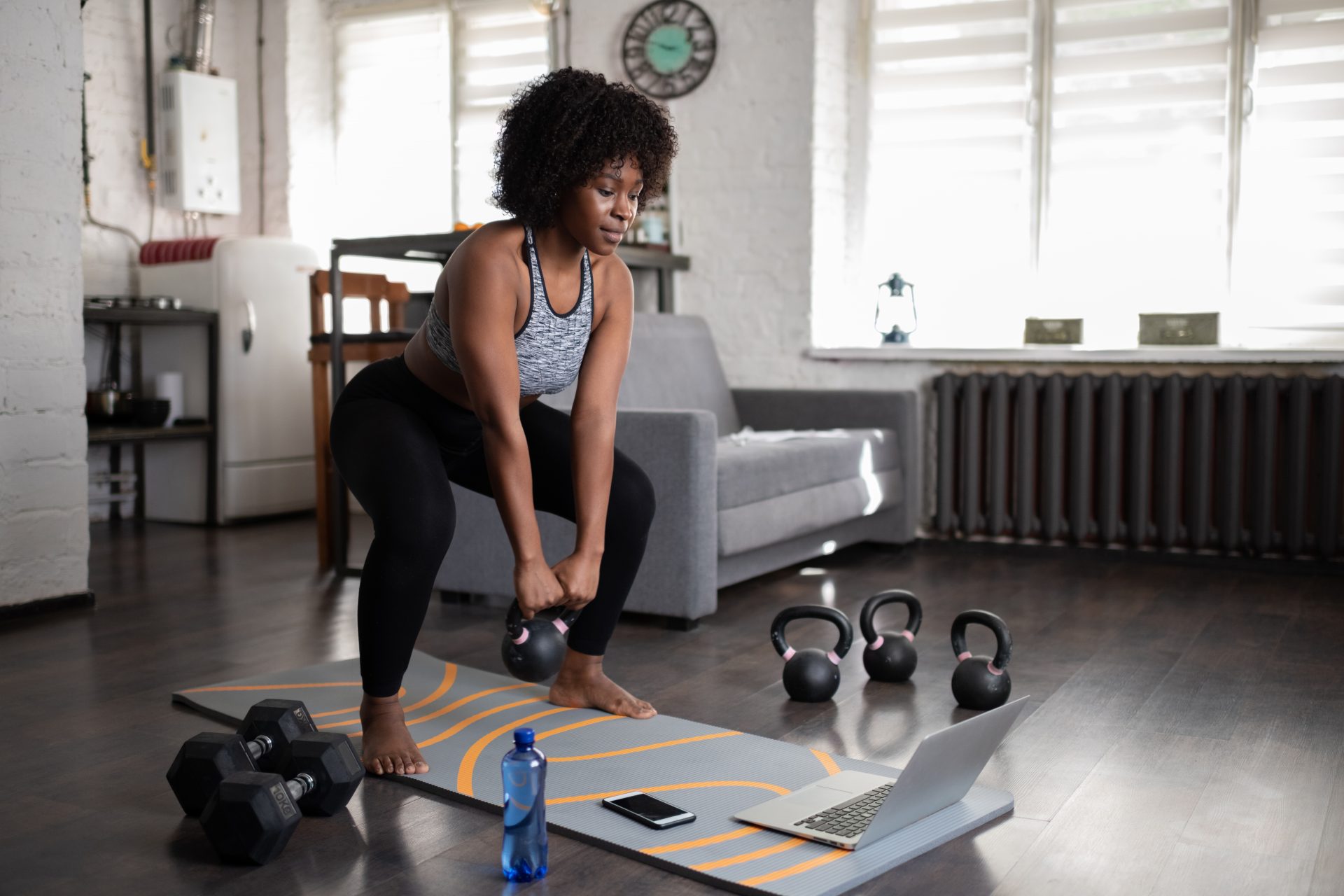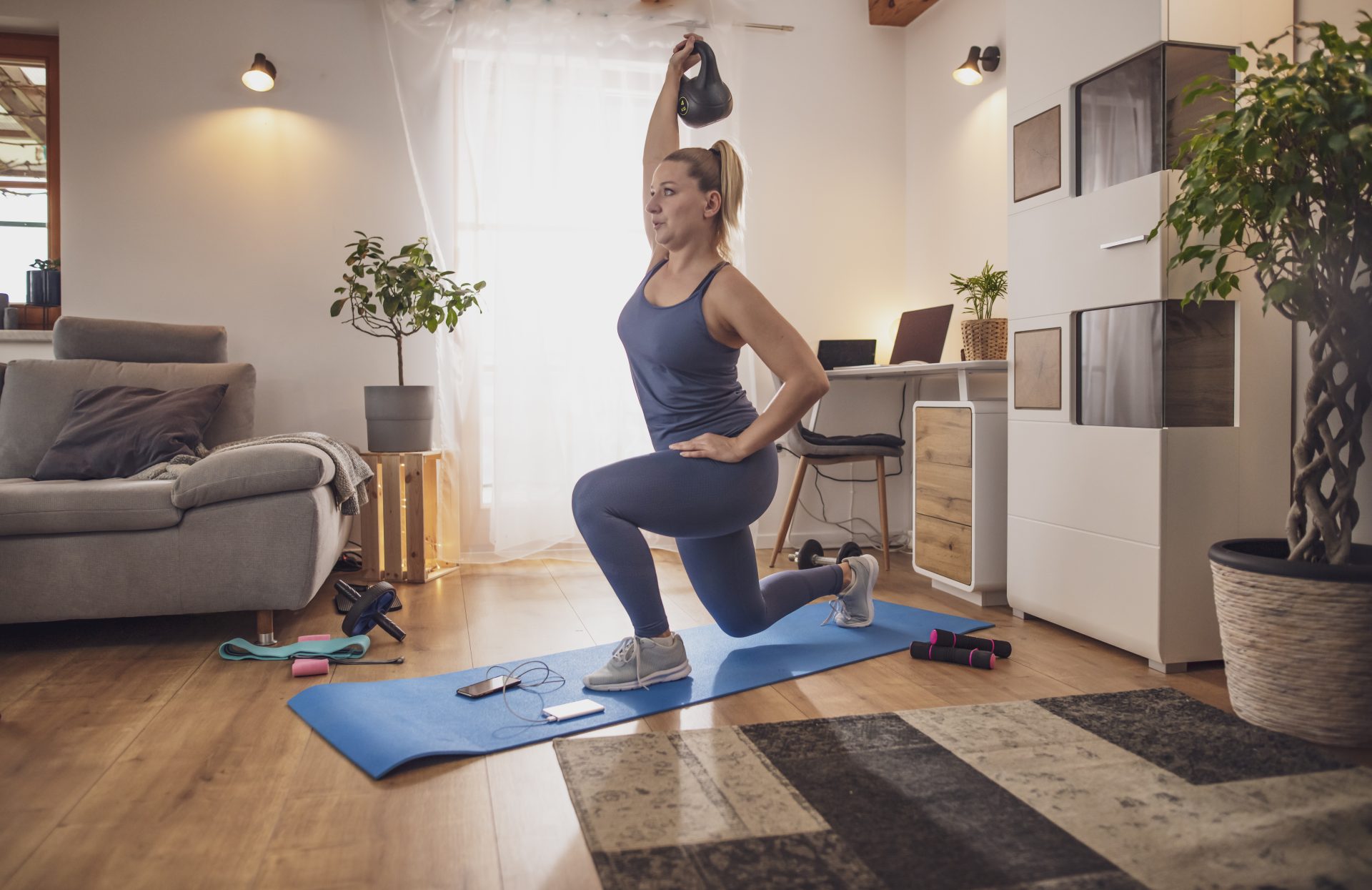Avoid these 4 common injuries while working out at home

Physios, osteopaths and PTs reveal the most common home workout injuries – and how to avoid them.
While it’s great that home workouts have made fitness more accessible, it does not come without its risks. The main one being: the possibility of injury. Without observation from a qualified fitness professional who can oversee our form, correct our alignment and answer our questions, it’s easy to end up hurting ourselves.
In addition, many of us are exercising more frequently than usual during lockdown (possibly even overtraining) and doing so at home in spaces that might be limited and cramped – resulting in self-inflicted aches, pains and strains.
Investing in a virtual one-on-one session with a PT can help to avoid injury, but not all of us are able to afford doing so. So how else can we avoid hurting ourselves while working out from home? Personal trainers, physios and osteopaths share the most common injuries and how to avoid them.
You may also like
How to strength train and avoid injury
Back injuries from poor form (and sitting down too much)
Physiotherapist Nicki Finn says that she’s been “seeing an alarming number of acute disc prolapses,” otherwise known as a slipped disc, which is caused by HIIT-style home workouts. Exercises such as burpees, mountain climbers and tuck jumps favour the muscles located on the front of our bodies – which are already shortened and tight. These exercises, coupled with core movements such as Russian twists or wood chops, create “a perfect storm for increasing compressive forces on your spine, and ultimately, resulting in injury.”
Amy Price Hoover, personal trainer and owner of APHysio, agrees that back injuries are the most prevalent right now. “People are often unaware of proper hip, core, and spine alignment and activation; so they end up with imbalances in these muscle groups or poor posture during workouts.” This leads to the overuse of our small back muscles or puts strain on the small joints of the spine. Underuse of our larger prime movers – namely the glutes – results in back pain or injury as well.
To prevent back pain, Amy suggests maintaining a neutral spine during compound movements such as squats, lunges and shoulder presses. When doing spinal movements such as twists, bends or rotations, ensure you don’t “dump your weight into your spine without proper hip and core engagement”.
Personal trainer Christina Forrest believes that back issues are also linked to “sitting at a desk all day, which causes bad posture and prevents us from engaging core muscles when lifting weights, particularly in the lower lumbar spine.” If you feel back pain while lifting weights at home, take a moment to realign your body and engage your core. Research also suggests that working on your hip mobility, which suffers when we sit for too long, helps to reduce back pain.

Shoulder and neck pain from lifting incorrectly (and poor posture)
When we sit in front of screens for hours on end, our chest muscles become tighter than they should be and our posture suffers – which has a knock-on effect on how we move during home workouts. “Our spinal posture drives the way our limbs work, and this is true especially for the shoulders,” Amy explains. With tight muscles in front and underused or weak muscles surrounding our shoulder blades, the risk of rotator cuff tendonitis or shoulder impingement is increased.
During upper body sessions that involve lifting weights overhead or fast arm movements, correct posture and shoulder positioning are essential. “Engage your shoulder blade muscles by pushing them down your back and gently pulling them together to create an open chest,” advises Amy. “This will allow the arm and shoulder to lift in a proper alignment and move more freely without stressing the shoulder joint.”
Warming up your shoulders with chest stretches and shoulder rolls gets the blood pumping and improves mobility, while stretching the chest, upper back and shoulder muscles after an upper body workout helps to prevent alignment issues and shoulder injury, she adds.
You may also like
How to work out at home and not risk an injury, according to PT Alice Liveing
Joint injuries from explosive, high-impact movements
Explosive, high-impact movements, such as burpees and tuck jumps found in many online HIIT classes, can also result in joint injuries in the ankles, hips and wrists, says Eve Powell, lead instructor at Third Space. “Allow your body a proper mobility phase – such as eight-to-12 minutes long – to warm up for this style of training. Applying this discipline to your home training is a form of self-care. Use it as a time to check in with your body and warm up safely and effectively.”
Eve also recommends adding variety to your training to protect your joints. “If you love high-impact workouts, incorporate some low-impact steady state (LISS) sessions. Pilates, barre, resistance band workouts, yoga and mobility are all excellent ways to lower the risk of injury. These will build more endurance and strength around the muscles surrounding your joints.”
She also suggests incorporating unilateral exercises, such as single leg deadlifts and single arm rows, to prepare for high-impact workouts. “We’re not all symmetrical so it’s important to work on our muscle imbalances and train in a multi-dimensional way.” Also invest in good-quality equipment if you can; Eve recommends a supportive workout mat from Yogi Bare.
You may also like
Mobility workout: move better and prevent injury with mobility exercises
Knee and ankle pain from overtraining
Lockdown has turned us into a nation of runners, and osteopath Hannah Williams of Burton Joyce Osteopathy says that knee and ankle injuries are “by far the most common injury” that she’s seeing at the moment. “Patella tendonitis, Achilles tendonitis, aggravation of arthritis and ligament strains,” which are often caused by overtraining are becoming frequent injuries. “People are understandably keen to get out and do more, but going from running or exercising once or twice a week, to daily workouts is a huge increase of demand on the body. This can lead to repetitive strain injuries, muscle fatigue and slowed repair.”
Hollie Maskell, a specialised musculoskeletal physiotherapist echoes this, saying that she frequently sees overuse in injuries such as repetitive trauma to the joints, muscles or tendons – particularly of the knees. She advises against putting excessive weight through the knees until the pain is manageable. “No more than a four out of 10 pain is considered a ‘safe pain’ zone. For example, if you’re feeling pain when squatting while holding a weight, try doing it without the weight. Once the pain settles, you can gradually increase the weight.”
Other factors, such as weakness around the knee joint and glute muscles can contribute to knee pain. To counteract this, Hollie recommends regular stretching and specific knee-strengthening exercises.
Prepping the body before each session and starting out slow is another way to prevent overuse injuries, says Rachael Penrose, personal trainer and group fitness trainer at F45 Training. “Don’t jump in and do a 10km run straight away. Instead, start with a 3-5km run twice a week, for a few weeks, and gradually progress over time.”

Do a dynamic warm up before a run or HIIT session, she adds. “Focus on your ankles and calves, mobilise your hips, switch on your core, and get movement into your shoulders and neck.” Then take time to stretch and cool down afterwards – paying attention to your glutes and quads.“Try holding a stretch for about 20 seconds to release the stress and strain.” If you suffer fromshin splints, try switching up the surface you run on. “A grass park has a lot more give than a concrete road.”
The take home
If you want to avoid hurting yourself, don’t follow fitness advice from unqualified people online, warns Rachael. “Asking a qualified trainer or paying for group workouts or PT sessions may seem expensive at first, but weigh up the potential costs. Taking the cheap route of watching Instagram workout videos may end in numerous physio visits and months of rehab. I’d much prefer to get it right the first time, learn from a professional and pick-up skills that will hold me in good stead for years to come.”
Follow @StrongWomenUK on Instagram for the latest workouts, delicious recipes and motivation from your favourite fitness experts.
IMAGE: Getty
Source: Read Full Article